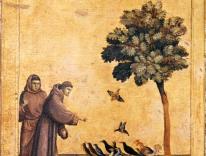One day I call a friend in San Francisco, the most erudite oenophiliac guy you ever met, a guy who knows more about wine and wine history and wine culture and wine production and wine marketing and wine details and wine quality and lack thereof than anyone in the whole wild world, and I say Hey Gerald, here’s a poser for you that’s always niggled at me: What wines would have been in those big jars at the wedding in Cana, and what wines would have been near Christ’s elbow at the Last Supper?
A difficult question to answer, he says. But if we put together what we know about wine in the ancient world, and what we know about some wine practices in the same areas today, we might conclude that it was common to allow the grapes to dry slightly before they were crushed and fermented, raising the potential alcohol content to a level that would help prevent spoilage, concentrate the acidity so the pH would be lowered and prevent bacterial activity, and probably leave some residual sugar, always welcome in the ancient world-caloric content, you know, for the energy needed for constant physical labor. The ancients, you will remember, did not have alcohol to fortify their wines-the Arabs invented distillation much later-and keeping wines wholesome once a jar was opened must have been a problem.
Let me further speculate, said my friend, that whatever was happening in Phoenicia, where winemaking skill originated, was also happening in Crete, where wines have been produced since time immemorial, and I have studied the story of wine in Crete with some attentiveness. The reputation of Cretan wine in imperial Rome was as great as it had been in classical Greece five centuries earlier, and at least a thousand years before that the Minoans had produced wine in the same areas. The wine called malmsey, for example, which made Venice rich and England happy, probably resembled, at the very least, similar wines produced on Crete-a dark smoky amber wine, redolent and relatively sweet. Remember that Homer’s descriptions of wine are almost always qualified by words and phrases suggesting honeyed sweetness. His descriptions of wines are at least consistent with his account of grapes left in the sun to dry before pressing. And that seems still to have been the practice when we again become aware of Cretan wine at the start of the thirteenth century, when, as her share of the spoils of Byzantium, Venice grabbed Crete.
So what Christ would have sipped was sweet? I ask.
Quite likely.
This makes me ponder that mysterious and paradoxical young Jewish man, and to think about him for the thousandth time not as God but as a guy, traveling and eating and drinking with his friends, and telling stories, always telling stories. I note to my erudite friend that Christ was very familiar indeed with grapevines and fruit, that he often used vines and wines as metaphors in his stories, and that he actually did of course once make wine, anywhere from 120 to 130 gallons at Cana (“six stone water pots...containing twenty or thirty gallons each,” notes John in his Gospel, one of the rare moments when the poetic Beloved Apostle attends to factual detail), and that Christ’s wine was ranked as “good” by the startled headwaiter, but that the Christos-real name, Yesuah ben Joseph-is hardly recorded as drinking wine in the Gospels, except for the sponge full of sour wine forced into his mouth as he died, but that he must have sipped and savored many a wine in his day, because he says at the Last Supper that he will not drink of the fruit of the vine again until he can drink it new with his companions at the coming of the kingdom of God, a remark I always found hauntingly sad.
That night with dinner I open a fruitful bottle of Shiraz, and silently dedicate the first sip to the young man who died long ago believing that love would defeat murder, life defeat death, hope defeat despair. How wrong he was, considering all the evidence since-but how right I hope him to be. L’Chayim.
Please email comments to [email protected] and join the conversation on our Facebook page.
Share
Previous Story
Palestine's New Bishop
Next Story
Vision Quest

